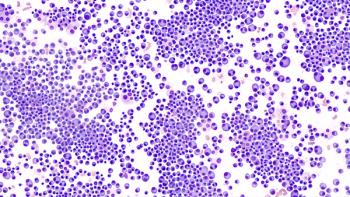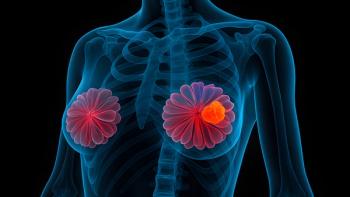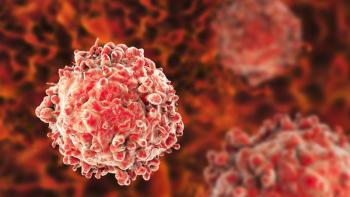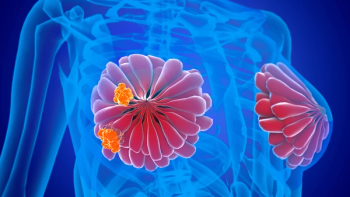
Managing Acute and Late Adverse Effects of Breast Cancer Radiation

Dermatitis and lymphedema are among the most pertinent adverse effects of radiation to the breast, according to Alexa M. Lantz, MSPAS, PA-C.
Adverse effects (AEs) of radiation center largely around the site of radiation, which, for breast cancer, can include dermatitis of the breast, lymphedema around the arm, and cardiac toxicities, according to Alexa M. Lantz, MSPAS, PA-C, who presented best practices for interdisciplinary management of radiation AEs at JADPRO Live 2025 in National Harbor, Maryland.1
Lantz, a physician assistant in radiation oncology at Penn State Milton S. Hershey Medical Center in Hershey, Pennsylvania, emphasized that most AEs with radiation are dependent on where the external radiation is aimed, despite common misconceptions that certain physical AEs are general to radiation therapy. She also presented management strategies for AEs in breast cancer, among others.
Acute Adverse Effects of Breast Cancer Radiation
Dermatitis
Patients undergoing radiation for breast cancer are susceptible to dermatitis around the breast and arm area due to the concentration of radiation on the skin in those cases. APPs should treat patients undergoing breast radiation proactively to prevent dermatitis, explained Lantz.
Methods for preventing breast dermatitis include using moisturizers, calendula-based topical applications, topical steroids such as daily 0.1% mometasone, and barrier films such as Mepitel, along with avoiding friction and irritants.
Once treatment begins, grade 1 dermatitis presents as faint erythema and dry desquamation. Lantz compared the condition to a mild sunburn. At the onset of grade 1 dermatitis, patients should continue to receive moisturizing agents along with steroids, but treatments should be personalized to the patient’s symptoms to an extent.
“We can add some different scopes to that, especially if they get some discomfort,” said Lantz in her presentation. “Maybe general ibuprofen is usually helpful with the stinging feeling that comes with it, but some patients will also get some topical burning sensations like a bad sunburn.”
Treatments for grade 1 dermatitis of the breast can also include saline, sitz, and vinegar soaks, as well as over-the-counter oral analgesia or topical lidocaine.
Breast dermatitis at grades 2 and 3 comprises moist desquamation and blistering. Interventions beyond those used for grade 1 condition include topical silver sulfadiazine, medicated soaks for rashes such as Domeboro, hydrocolloid dressings, and triple antibiotic creams or oral antibiotics such as cephalexin.
In the case of infection onset, a treatment break should be considered. If dermatitis reaches grade 4, which presents as hemorrhage or necrosis, patients should be referred to wound management, and radiation should be discontinued.
Pruritus and Pain
Patients may develop hand or skin itching, called pruritus, which can be managed with a hydrophilic moisturizer and topical mild steroids when needed. Over-the-counter pain medication can help with painful dermatitis.
Lymphedema
In patients receiving radiation to the breast, lymphedema occurs most commonly in the arm, sometimes called elephant arm, but can also appear at the side of the chest and axilla. Lantz shared that her patients are referred to a lymphedema therapy clinic, where occupational therapists specializing in lymphedema help patients by using tools such as compression devices and give them a home program to follow to continue their recovery.
In an interview with Oncology Nursing News following her presentation, Lantz shared that for patients who either travel to clinics with a lymphedema specialist or those being treated at clinics without one, there may still be a specialist within a reasonable distance from the patient.
“At that point, I’m honestly googling what physical therapy and occupational practices are near [the patient]. I usually will make a phone call and say, ‘Does anybody here specialize in lymphedema therapy?’, specifically in the type of cancer [the patient] has,” said Lantz. “If they say ‘yes’, wonderful, I refer them there. If they say ‘no’, I make a couple more phone calls until I can find a clinic that does.”
Late Adverse Effects of Breast Cancer Radiation
Cardiac Toxicities, Fibrosis, and Pneumonitis
Cardiac toxicities are possible late effects of breast radiation but are a greater concern for patients with left breast cancer, as the heart is closer to the area of radiation.
To mitigate cardiac toxicities, radiation teams will work with patients on maneuvers such as deep inspiration breath to protect the patient’s heart, said Lantz. According to the Cleveland Clinic, holding a deep breath for 20 seconds (deep inspiration breath hold) draws the heart away from the chest, providing protection to the heart and allowing radiation to occur to the breast while minimizing cardiac event risk.2
Possible cardiac toxicities include coronary artery disease, cardiomyopathy, valvular disease, arrhythmia, and pericarditis.1 While Lantz said that patients do not usually require a cardiology referral, if patients have a preexisting heart-related condition, a consultation with the patient’s cardiologist is recommended.
If a referral for cardiovascular assessment is necessary, the cardiology team may order echocardiograms, stress tests, or a lipid profile. Possible cardiac toxicity management may include statins, beta blockers, ACE inhibitors, or antiplatelet therapy. Nonsteroidal anti-inflammatory drugs (NSAIDs) can be used for pericarditis. Percutaneous coronary intervention or valve replacement surgery may be necessary.
Fibrosis, or thickening and scarring of tissue in important organs, may develop late and can be managed with physical and occupational therapy as well as pentoxifylline with vitamin E. Pulmonary fibrosis as well as pneumonitis are both possible in the breast setting, but are more common in thoracic cancers, according to Lantz.
Hyperpigmentation, Telangiectasia, and Volume Loss
Hyperpigmentation, or an overproduction of melanin,3 and telangiectasia, a condition where blood vessels are enlarged, causing redness of the skin or mucous membranes,4 are possible late AEs of breast radiation. Lantz recommended laser therapy and a hydrophilic moisturizer for these conditions.1
For patients who have had a partial mastectomy prior to radiation, the tissue around the breast may tighten, resulting in breast volume loss. Patients experiencing volume loss should have access to a prosthesis or surgical correction.
Lantz shared that a location near her institution offers custom bras that may help patients feel more comfortable.
Rare Adverse Effects of Breast Cancer Radiation
An additional acute AE of radiation to the breast that occurs rarely is costochondritis, or rib irritation. Costochondritis should be managed with NSAIDs; for example, Lantz said that 200 to 800 mg of ibuprofen should be sufficient.
Brachial plexopathy, a form of peripheral neuropathy occurring from damage to the brachial plexus, occurs rarely as a late AE of breast cancer radiation as well. Symptoms include numbness, pain, tingling, or weakness in the shoulder, arm, and hand area.5 According to Lantz, it can be managed with anticonvulsant gamma-aminobutyric acid analogs gabapentin or pregabalin, along with physical/occupational therapy.1
References
- Lantz, AM. A team-based approach to the management of acute and late radiation side effects. Presented at: JADPRO Live 2025; October 23-26, 2025; National Harbor, Maryland.
- Deep inspiration breath hold in breast cancer treatment. Cleveland Clinic. Updated January 7, 2019. Accessed October 28, 2025. https://my.clevelandclinic.org/health/treatments/16711-deep-inspiration-breath-hold-in-breast-cancer-treatment
- Hyperpigmentation. NCI Dictionary of Cancer Terms. Accessed October 28, 2025. https://www.cancer.gov/publications/dictionaries/cancer-terms/def/hyperpigmentation
- Telangiectasia. MedlinePlus.gov. Updated June 7, 2023. Accessed October 28, 2025. https://medlineplus.gov/ency/article/003284.htm
- Brachial plexopathy. MedlinePlus.gov. Updated June 13, 2024. Accessed October 28, 2025. https://medlineplus.gov/ency/article/001418.htm
Newsletter
Knowledge is power. Don’t miss the most recent breakthroughs in cancer care.
















































































